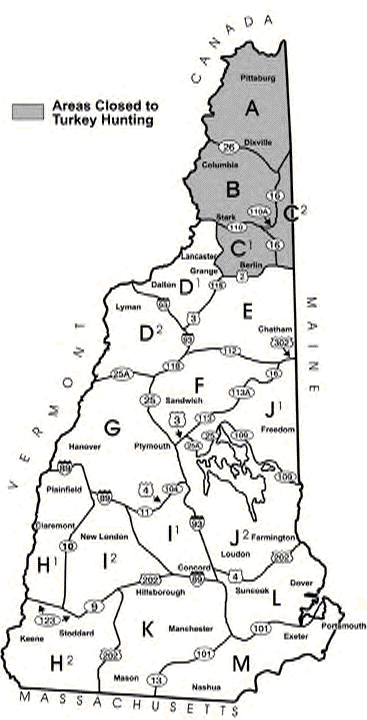| Wild Turkey |
| Spring Season: May 3-31 One bearded turkey by shotgun or bow Fall Season Sept. 15-Dec. 15 One wild turkey, either sex Archery only Areas Open to Wild Turkey Hunting: Wildlife Management Units D1, D2, F, G, E, H1, H2, I1, I2, J1, J2, K, L, M Areas CLOSED to Wild Turkey Hunting: Wildlife Management Units: A, B, C1, C2 For details on seasons, shooting hours, and other rules, please consult the N.H. Hunting Digest. |
 |
Early warm-up a mixed blessing.
| May 2, 2002 - The forecast for this year's wild turkey season in New Hampshire is looking pretty good, according to Ted Walski, turkey project leader for the state Fish and Game Department. "The easy winter, with food plentiful, coupled with high production of young last summer, should result in another record harvest during the spring gobbler hunting season," Walski said. "Last year there were 2,260 gobblers registered. This year I guesstimate a harvest of 2,700 turkeys." New Hampshire's wild turkey season runs May 3 through May 31. Hunters need a hunting license and a wild turkey permit, available wherever fishing and hunting licenses are sold and online at www.wildlife.state.nh.us. All of the state is open to wild turkey hunting, except the northern Wildlife Management Units of A, B, C1 and C2. Walski took careful note of the early greening that came with the unusually warm conditions in April. "The green grass and leaves out on shrubs and trees on April 22 are about where conditions would normally be on May 15, or three weeks earlier than normal," he said. "You won't hear gobbling nearly as far because the leaf-out of the vegetation significantly absorbs sound, and you won't see the gobblers from any long distance. Therefore, use extra effort in not moving, because turkeys will be sneaking in quite close before you see them." During the past two weeks, more and more hens have been breaking away from the bigger turkey groups to lay an egg a day and be near their nest sites, he said. "Lately I've been seeing numerous single hens, and smaller groups of two or three toms and jakes with three or four hens. During an average spring in the southern half of New Hampshire, hen turkeys usually begin laying eggs on about April 15. With more hens out of the way, it should be easier for more gobblers to come in." Walski predicts that most of this spring's hatching will happen during the last two weeks in May, rather than during early June. So, hunters out in late May should expect to run into some hens with chicks. This spring's turkey hunt is the 23rd since wild turkeys were successfully reintroduced to New Hampshire in 1975. That's the year the New Hampshire Fish and Game Department obtained 25 wild turkeys from the Allegheny Mountains in southwestern New York state and released them in the Connecticut River valley in Cheshire and Sullivan counties. Since then, wild turkeys have prospered in New Hampshire. As of August 2001, the statewide wild turkey population was estimated to exceed 22,000. The success story wouldn't have been possible without the Federal Aid in Wildlife Restoration Program. In this program, an excise tax on firearms, ammunition, archery equipment and certain other hunting items provides funds for wildlife restoration and management, hunter education, habitat protection and many other conservation activities. It's a partnership among hunters, manufacturers, the U.S. Fish and Wildlife Service, and state fish and wildlife agencies. Tips for Safe Turkey Hunting 1) Keep shots at a reasonable distance -- within 30 yards. 2) Don't try to stalk a turkey. The chance of getting close enough for a good shot are slim. If you're stalking what sounds like a turkey, chances are good you are stalking another hunter using a turkey call. Instead, sit down and use your call; let turkeys come to you. 3) Don't wear colors common to a strutting gobbler-- red, blue, black and white. 4) Wear a piece of blaze-orange clothing when moving to and from turkey calling locations, as well as when carrying a turkey out of the woods. |